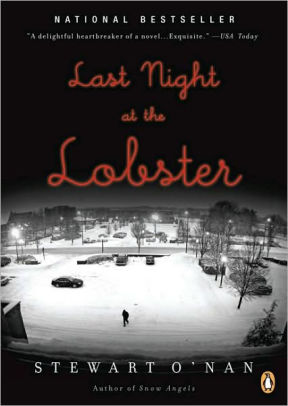
Last Night at the Lobster
Author: Stewart O’Nan
Publisher: Penguin Group (USA)
Date of Publication: November 1, 2007
Pages: 160
Some authors write great epics
about heroic people. Others write about
ordinary people in extra-ordinary circumstances. I’ve always admired authors who could tell
stories about ordinary people and their every-day lives and make those stories
interesting. It’s an added bonus if the
author can make those same stories humorous, poignant and thought provoking at
the same time. Anne Tyler is one of
those authors. So is Stewart O’Nan. In this novel Stewart O’Nan creates a culture
of average lower middle class workers and restaurant customers who collectively
tell an all too familiar story of displacement, insecurity and anxiety. He introduces these characters quickly but
deftly and uses dialogue to help us know and understand them like they were old
friends.
Last
Night at the Lobster is O’Nan’s twelfth novel. He also has several non-fiction titles to his
credit, including one he co-wrote with Stephen King about the Boston Red
Sox. The author grew up in Pittsburgh , went to undergraduate school at Boston University
and now lives in Connecticut New England
is the setting for this wonderful short novel.
The novel describes closing night
for a marginally successful Red Lobster just off of an interstate highway in Connecticut
The novel opens with Manny parking
his dilapidated Buick Regal in the Lobster parking lot and smoking a joint
before opening. A major snowstorm is
beginning as well. Manny has to deal
with his disgruntled employees, some of whom have been let go and four of which
are following Manny to the Olive Garden.
There are petty jealousies among the waitresses and major attitude
problems with the kitchen staff.
The rest of this short novel (or
long short story) details the frustrations and disasters which occur on this
last evening. A large office party comes
in and neither waitress wants them because large parties are notoriously bad
tippers. Two women have lunch with a
totally undisciplined toddler. The final
blow comes right before closing when a busload of Japanese tourists come in to
use the bathroom (the bus driver claims that they all got dysentery at a Red
Lobster farther south on the interstate).
All the while Manny has to juggle a
minimal inventory, malfunctioning equipment, a blizzard and employee
insurrection. Few of you know this about
me, but I abandoned a career in the restaurant business to pursue medicine. I had rocketed through the fast food industry
and was the “Special Whopper” bench guy at the Falls Church Burger King when I
realized there had to be a better way to make a living. While in college I also worked for a year or
so at Blackie’s House of Beef at 22nd and M Streets in D.C. (Anyone
ever go there? Remember the blue cheese
and crackers before dinner?). I can recognize
some of my own restaurant experiences in this melancholy, but at times
hilarious, novel.
Last
Night at the Lobster does have a purpose other than pure entertainment,
however. I think that the value of the
book is that it points out the comfort of familiarity and the reassurance of
routine. The closing of this restaurant
rocks Manny’s world, as well as that of all of the other characters in the
book, including the regular customers.
Uncertainty and change do not always bring out the best in people, as
this book demonstrates quite well. One
reviewer calls Last Night at the Lobster “a
perfectly observed slice of working class life.” This book was written and published long
before this current economic crisis and job loss. However, the author creates very real
characters and uses dialogue superbly to tell a fabulous fable for our
times.
(Note: This Review was originally published in "LamLight", the physician newsletter for the Lynchburg Academy of Medicine in 2008)